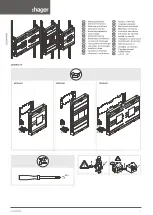
4
H. Preparation Before Use
•
Nuts not sufficiently torqued can cause the heat exchanger to leak.
•
Sanitizing with hot water is a safety hazard. Ensure hot water does not come into contact with the operator or bystanders.
•
If sanitizing with chemicals, follow all of the chemical supplier instructions.
1.
Check if the clamp nuts are at sufficient torque to not leak at the intended pressure.
2.
Perform a leak test with 1.25x of the intended operating pressure 30 minutes before using.
3.
Rinse the exchanger with tap water for 20 minutes.
4.
It is important to purge all air from the heat exchanger to maintain efficiency. If needed, add a purging valve to the highest point of
the product path.
5.
Sanitize with hot water (180—200°F), and then turn on the product pump to expel all the water in the exchanger until there is no water
left. (For beer wort production, the exit of the heat exchanger should be at 180°F for 30 seconds to be considered sanitized).
6.
If the intended use requires the heat exchanger flows to be at different pressures (i.e. for use with steam), turn on the low-pressure
valve first and then the high-pressure valve. When done, slowly shut off the high-pressure flow followed by the low-pressure flow
when stopping the exchanger. It should be noted that following this procedure will preserve the lifespan of this device by minimizing
the stress on the plates.
I. Cleaning After Each Use
1.
Rinse thoroughly after each use. Cleaning after each batch is necessary because debris might accumulate on the plates during use. It
is unnecessary for the exchanger to be taken apart for cleaning after each use. Since internal debris can be expelled from the device
by running water in the opposite direction (back-flow) of the media with a hydraulic pressure lower than the operating pressure. In
addition, cleaners that are non-corrosive to the stainless steel can be used. (Non-chlorinated caustic followed by an acid rinse is com-
mon practice).
J. Maintenance
1.
Disassembly of the heat exchanger will be required to clean all debris from the heat exchanger completely. This maintenance interval
needs to be specified based on the facility’s processes and should be performed at least every 100 batches in a brewery.
2.
After disassembly, clean the surfaces of the plates with a nylon brush. It is very important to maintain the exact order and orientation
of the plates during disassembly and cleaning to maintain the proper function of the heat exchanger. Do not scratch the plates during
cleaning.
3.
During assembly, the plates are pressed between the panels by torquing the bolts. It is essential to torque evenly in a cross pattern
to ensure the seals remain parallel and do not leak. Measure the distance between the panels in all four corners and make sure they
remain equal.
TIP
:
It is normal for this measurement to be slightly smaller each time the exchanger is reassembled until finally the plates are metal on
metal, and the seals require replacement.
4.
Regular inspection of the assembly torque is required to prevent leaks.
5.
To replace the seals:
1.
Remove the old seal and any glue that is left on the plate. Ensure the plate is clean and dry.
2.
Apply 3M 1099 glue (can be purchased online or a hardware store) to the back of the new seal and press it into the groove. Wait
72 hours for the glue to dry and then reassemble the device.
Troubleshooting
Before troubleshooting, it is important to know the basic operating parameters of your process. There are six temperatures and three flow
rates that are indicative of how the process is running:
• Product inlet temperature
• Product outlet temperature
• Product flow rate
• Cooling water inlet temperature
• Cooling water outlet temperature
• Cooling flow rate
• Chilled liquor inlet temperature
• Chilled outlet temperature
• Chilled liquor flow rate























